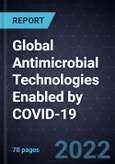Innovation Culture and Growth Strategies Catalyzed to Prevent Infections
Antimicrobial technology has previously seen wide adoption in antimicrobial additives, coatings, and films in consumer health applications. However, with the emergence of COVID-19, the demand for antimicrobial technology has driven innovations, such as graphene nanoparticles (NPs), photocatalytic additives, and antimicrobial polymer nanomaterials, in developing high-temperature resistance, non-toxic antimicrobial disinfectants, and long-lasting antimicrobial technology adoption in consumer health, building and construction, automotive, and consumer goods applications. Antimicrobial technology materials include antimicrobial polymers; composites, metal-based antimicrobial agents; nanomaterials; natural-based antimicrobial agents; antimicrobial peptides (AMPs); and other materials, such as phenolics, amidines, and biguanides.
Due to their stable structure, metal ions and metal-oxide ions have found use in medical and food packaging applications. The use of ultra-thin two-dimensional materials like black phosphorus and graphene on antimicrobial surfaces has been a focus of technology development initiatives following the outbreak of COVID-19. In addition to antimicrobial surfaces, implants, medical devices, food packaging, building and construction materials, and textiles have all experienced a spike in interest for antimicrobial coatings. The need for active packaging that exhibits high antimicrobial features for food and personal care applications following COVID-19 has prompted industry stakeholders and researchers to continue pursuing their work with natural antimicrobials such as chitin-chitosan and peptides to develop biodegradable, safe, yet high-performance antimicrobial films.
The research will answer the following questions:
- What factors will drive antimicrobial technology adoption post COVID-19?
- What challenges and impediments restrain antimicrobial technology adoption?
- What initiatives are industry participants undertaking to accelerate adoption across industries?
- What previous challenges does antimicrobial technology adoption across applications address?
- What growth potential exists for commercializing antimicrobial technologies across industries?








